Product Info Summary
| SKU: | A01470-1 |
|---|---|
| Size: | 100 μg/vial |
| Reactive Species: | Human, Mouse, Rat |
| Host: | Rabbit |
| Application: | ELISA, Flow Cytometry, IF, IHC, IHC-F, ICC, WB |
Customers Who Bought This Also Bought
Product info
Product Name
Anti-strogen Related Receptor gamma/ESRRG Antibody Picoband®
View all ERR gamma/NR3B3 Antibodies
SKU/Catalog Number
A01470-1
Size
100 μg/vial
Form
Lyophilized
Description
Boster Bio Anti-strogen Related Receptor gamma/ESRRG Antibody Picoband® catalog # A01470-1. Tested in ELISA, Flow Cytometry, IF, IHC, IHC-F, ICC, WB applications. This antibody reacts with Human, Mouse, Rat. The brand Picoband indicates this is a premium antibody that guarantees superior quality, high affinity, and strong signals with minimal background in Western blot applications. Only our best-performing antibodies are designated as Picoband, ensuring unmatched performance.
Storage & Handling
Store at -20˚C for one year from date of receipt. After reconstitution, at 4˚C for one month. It can also be aliquotted and stored frozen at -20˚C for six months. Avoid repeated freeze-thaw cycles.
Cite This Product
Anti-strogen Related Receptor gamma/ESRRG Antibody Picoband® (Boster Biological Technology, Pleasanton CA, USA, Catalog # A01470-1)
Host
Rabbit
Contents
Each vial contains 4mg Trehalose, 0.9mg NaCl, 0.2mg Na2HPO4, 0.05mg NaN3.
Clonality
Polyclonal
Isotype
Rabbit IgG
Immunogen
E. coli-derived human ESRRG recombinant protein (Position: Q302-V458).
*Blocking peptide can be purchased. Costs vary based on immunogen length. Contact us for pricing.
Cross-reactivity
No cross-reactivity with other proteins.
Reactive Species
A01470-1 is reactive to ESRRG in Human, Mouse, Rat
Reconstitution
Add 0.2ml of distilled water will yield a concentration of 500ug/ml.
Observed Molecular Weight
51 kDa
Calculated molecular weight
51.306kDa
Background of ERR gamma/NR3B3
Estrogen-related receptor gamma (ERR-gamma), also known as NR3B3, is a nuclear receptor that in humans is encoded by the ESRRG gene. This gene encodes a member of the estrogen receptor-related receptor (ESRR) family, which belongs to the nuclear hormone receptor superfamily. All members of the ESRR family share an almost identical DNA binding domain, which is composed of two C4-type zinc finger motifs. The ESRR members are orphan nuclear receptors; they bind to the estrogen response element and steroidogenic factor 1 response element, and activate genes controlled by both response elements in the absence of any ligands. The ESRR family is closely related to the estrogen receptor (ER) family. They share target genes, co-regulators and promoters, and by targeting the same set of genes, the ESRRs seem to interfere with the ER-mediated estrogen response in various ways. It has been reported that the family member encoded by this gene functions as a transcriptional activator of DNA cytosine-5-methyltransferases 1 (Dnmt1) expression by direct binding to its response elements in the DNMT1 promoters, modulates cell proliferation and estrogen signaling in breast cancer, and negatively regulates bone morphogenetic protein 2-induced osteoblast differentiation and bone formation. Multiple alternatively spliced transcript variants have been identified, which mainly differ at the 5' end and some of which encode protein isoforms differing in the N-terminal region.
Antibody Validation
Boster validates all antibodies on WB, IHC, ICC, Immunofluorescence, and ELISA with known positive control and negative samples to ensure specificity and high affinity, including thorough antibody incubations.
Application & Images
Applications
A01470-1 is guaranteed for ELISA, Flow Cytometry, IF, IHC, IHC-F, ICC, WB Boster Guarantee
Assay Dilutions Recommendation
The recommendations below provide a starting point for assay optimization. The actual working concentration varies and should be decided by the user.
Western blot, 0.1-0.5μg/ml
Immunohistochemistry (Paraffin-embedded Section), 0.5-1μg/ml
Immunohistochemistry (Frozen Section), 0.5-1μg/ml
Immunocytochemistry/Immunofluorescence, 2μg/ml
Flow Cytometry (Fixed), 1-3μg/1x106 cells
ELISA, 0.1-0.5μg/ml
Positive Control
WB: human PANC-1 whole cell, human 22RV1 whole cell, human COLO-320 whole cell, human SW620 whole cell, mouse SP20 whole cell
IHC: mouse brain tissue, rat cardiac muscle tissue
ICC/IF: A549 cell
FCM: U20S cell
Validation Images & Assay Conditions
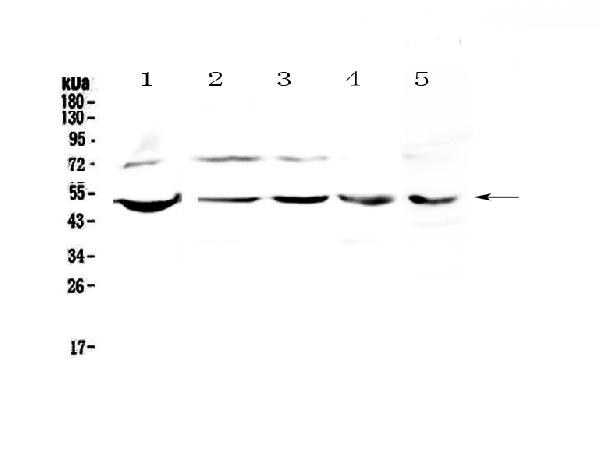
Click image to see more details
Figure 1. Western blot analysis of ESRRG using anti-ESRRG antibody (A01470-1).
Electrophoresis was performed on a 5-20% SDS-PAGE gel at 70V (Stacking gel) / 90V (Resolving gel) for 2-3 hours. The sample well of each lane was loaded with 50ug of sample under reducing conditions.
Lane 1: human PANC-1 whole cell lysates,
Lane 2: human 22RV1 whole cell lysates,
Lane 3: human COLO-320 whole cell lysates,
Lane 4: human SW620 whole cell lysates,
Lane 5: mouse SP20 whole cell lysates.
After Electrophoresis, proteins were transferred to a Nitrocellulose membrane at 150mA for 50-90 minutes. Blocked the membrane with 5% Non-fat Milk/ TBS for 1.5 hour at RT. The membrane was incubated with rabbit anti-ESRRG antigen affinity purified polyclonal antibody (Catalog # A01470-1) at 0.5 μg/mL overnight at 4°C, then washed with TBS-0.1%Tween 3 times with 5 minutes each and probed with a goat anti-rabbit IgG-HRP secondary antibody at a dilution of 1:10000 for 1.5 hour at RT. The signal is developed using an Enhanced Chemiluminescent detection (ECL) kit (Catalog # EK1002) with Tanon 5200 system. A specific band was detected for ESRRG at approximately 51KD. The expected band size for ESRRG is at 51KD.
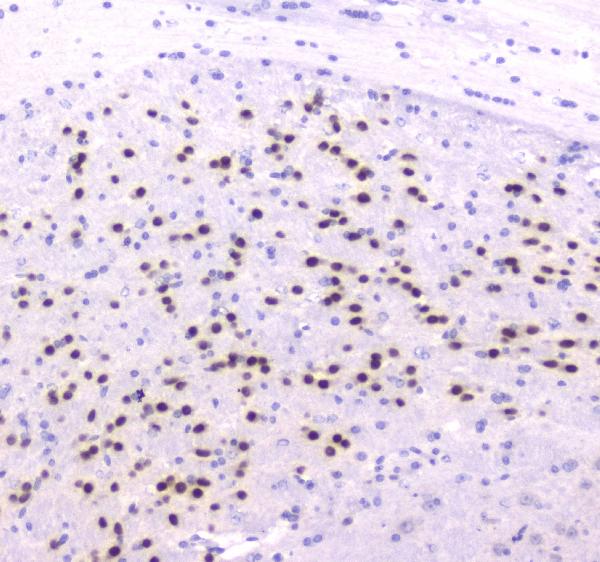
Click image to see more details
Figure 2. IHC analysis of ESRRG using anti-ESRRG antibody (A01470-1).
ESRRG was detected in paraffin-embedded section of mouse brain tissue . Heat mediated antigen retrieval was performed in citrate buffer (pH6, epitope retrieval solution) for 20 mins. The tissue section was blocked with 10% goat serum. The tissue section was then incubated with 1μg/ml rabbit anti-ESRRG Antibody (A01470-1) overnight at 4°C. Biotinylated goat anti-rabbit IgG was used as secondary antibody and incubated for 30 minutes at 37°C. The tissue section was developed using Strepavidin-Biotin-Complex (SABC)(Catalog # SA1022) with DAB as the chromogen.
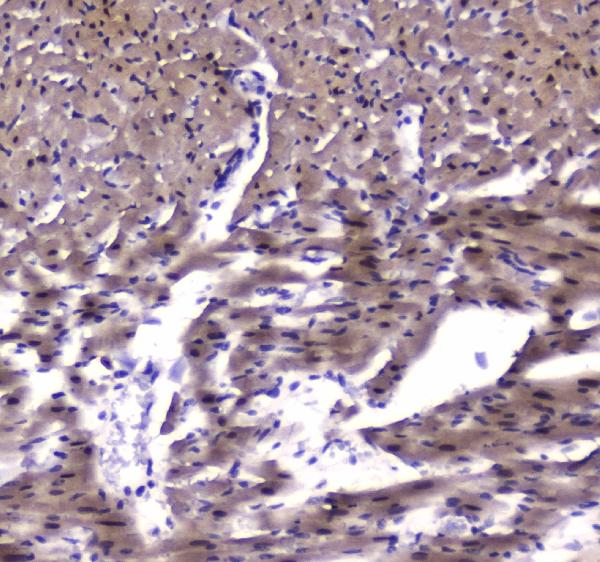
Click image to see more details
Figure 3. IHC analysis of ESRRG using anti-ESRRG antibody (A01470-1).
ESRRG was detected in paraffin-embedded section of rat cardiac muscle tissue. Heat mediated antigen retrieval was performed in citrate buffer (pH6, epitope retrieval solution) for 20 mins. The tissue section was blocked with 10% goat serum. The tissue section was then incubated with 1μg/ml rabbit anti-ESRRG Antibody (A01470-1) overnight at 4°C. Biotinylated goat anti-rabbit IgG was used as secondary antibody and incubated for 30 minutes at 37°C. The tissue section was developed using Strepavidin-Biotin-Complex (SABC)(Catalog # SA1022) with DAB as the chromogen.
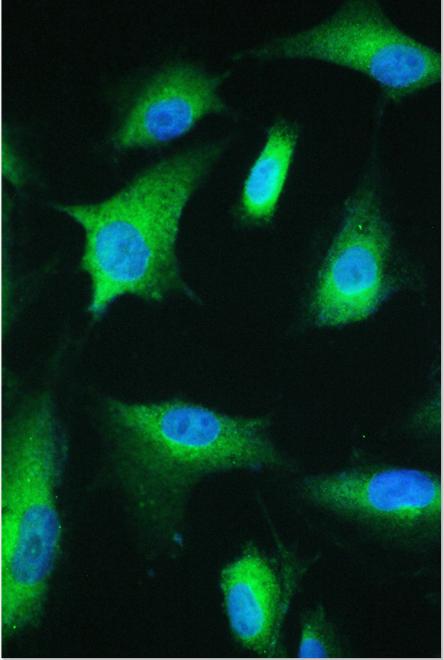
Click image to see more details
Figure 4. IF analysis of ESRRG using anti-ESRRG antibody (A01470-1).
ESRRG was detected in immunocytochemical section of A549 cell. Enzyme antigen retrieval was performed using IHC enzyme antigen retrieval reagent (AR0022) for 15 mins. The cells were blocked with 10% goat serum. And then incubated with 2μg/mL rabbit anti-ESRRG Antibody (A01470-1) overnight at 4°C. DyLight®488 Conjugated Goat Anti-Rabbit IgG (BA1127) was used as secondary antibody at 1:100 dilution and incubated for 30 minutes at 37°C. The section was counterstained with DAPI. Visualize using a fluorescence microscope and filter sets appropriate for the label used.
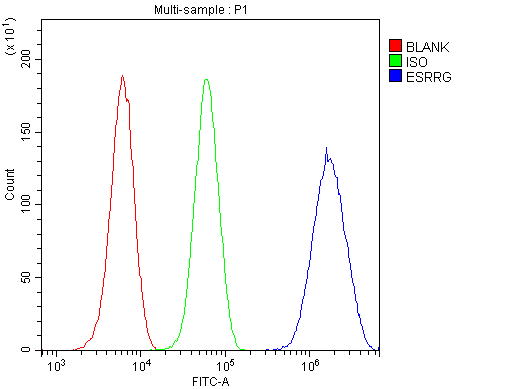
Click image to see more details
Figure 5. Flow Cytometry analysis of U20S cells using anti-ESRRG antibody (A01470-1).
Overlay histogram showing U20S cells stained with A01470-1 (Blue line). To facilitate intracellular staining, cells were fixed with 4% paraformaldehyde and permeabilized with permeabilization buffer. The cells were blocked with 10% normal goat serum. And then incubated with rabbit anti-ESRRG Antibody (A01470-1,1μg/1x106 cells) for 30 min at 20°C. DyLight®488 conjugated goat anti-rabbit IgG (BA1127, 5-10μg/1x106 cells) was used as secondary antibody for 30 minutes at 20°C. Isotype control antibody (Green line) was rabbit IgG (1μg/1x106) used under the same conditions. Unlabelled sample without incubation with primary antibody and secondary antibody (Red line) was used as a blank control.
Protein Target Info & Infographic
Gene/Protein Information For ESRRG (Source: Uniprot.org, NCBI)
Gene Name
ESRRG
Full Name
Estrogen-related receptor gamma
Weight
51.306kDa
Superfamily
nuclear hormone receptor family
Alternative Names
Estrogen-related receptor gamma; ERR gamma-2; Estrogen receptor-related protein 3; Nuclear receptor subfamily 3 group B member 3; ESRRG; ERR3; ERRG2; KIAA0832; NR3B3 ESRRG ERR-gamma, ERR3, ERRg, ERRgamma, NR3B3 estrogen related receptor gamma estrogen-related receptor gamma|ERR gamma-2|estrogen receptor-related protein 3|nuclear receptor subfamily 3 group B member 3
*If product is indicated to react with multiple species, protein info is based on the gene entry specified above in "Species".For more info on ESRRG, check out the ESRRG Infographic

We have 30,000+ of these available, one for each gene! Check them out.
In this infographic, you will see the following information for ESRRG: database IDs, superfamily, protein function, synonyms, molecular weight, chromosomal locations, tissues of expression, subcellular locations, post-translational modifications, and related diseases, research areas & pathways. If you want to see more information included, or would like to contribute to it and be acknowledged, please contact [email protected].
Specific Publications For Anti-strogen Related Receptor gamma/ESRRG Antibody Picoband® (A01470-1)
Hello CJ!
A01470-1 has been cited in 1 publications:
*The publications in this section are manually curated by our staff scientists. They may differ from Bioz's machine gathered results. Both are accurate. If you find a publication citing this product but is missing from this list, please let us know we will issue you a thank-you coupon.
Mitogen-activated protein kinase kinases promote mitochondrial biogenesis in part through inducing peroxisome proliferator-activated receptor γ coactivator-1β expression
Recommended Resources
Here are featured tools and databases that you might find useful.
- Boster's Pathways Library
- Protein Databases
- Bioscience Research Protocol Resources
- Data Processing & Analysis Software
- Photo Editing Software
- Scientific Literature Resources
- Research Paper Management Tools
- Molecular Biology Software
- Primer Design Tools
- Bioinformatics Tools
- Phylogenetic Tree Analysis
Customer Reviews
Have you used Anti-strogen Related Receptor gamma/ESRRG Antibody Picoband®?
Submit a review and receive an Amazon gift card.
- $30 for a review with an image
0 Reviews For Anti-strogen Related Receptor gamma/ESRRG Antibody Picoband®
Customer Q&As
Have a question?
Find answers in Q&As, reviews.
Can't find your answer?
Submit your question
7 Customer Q&As for Anti-strogen Related Receptor gamma/ESRRG Antibody Picoband®
Question
Thanks for helping with my inquiry over the phone. Here are the WB image, lot number and protocol we used for placenta using anti-strogen Related Receptor gamma/ESRRG antibody A01470-1. Let me know if you need anything else.
Verified Customer
Verified customer
Asked: 2020-01-22
Answer
Thank you for the data. You have provided everything we needed. Our lab team are working to resolve your inquiry as quickly as possible, and we appreciate your patience and understanding! Please let me know if there is anything you need in the meantime.
Boster Scientific Support
Answered: 2020-01-22
Question
We are currently using anti-strogen Related Receptor gamma/ESRRG antibody A01470-1 for mouse tissue, and we are satisfied with the ICC results. The species of reactivity given in the datasheet says human, mouse, rat. Is it likely that the antibody can work on primate tissues as well?
Verified Customer
Verified customer
Asked: 2019-09-23
Answer
The anti-strogen Related Receptor gamma/ESRRG antibody (A01470-1) has not been validated for cross reactivity specifically with primate tissues, but there is a good chance of cross reactivity. We have an innovator award program that if you test this antibody and show it works in primate you can get your next antibody for free. Please contact me if I can help you with anything.
Boster Scientific Support
Answered: 2019-09-23
Question
See below the WB image, lot number and protocol we used for placenta using anti-strogen Related Receptor gamma/ESRRG antibody A01470-1. Please let me know if you require anything else.
S. Yang
Verified customer
Asked: 2018-10-03
Answer
Thank you very much for the data. Our lab team are working to resolve this as quickly as possible, and we appreciate your patience and understanding! You have provided everything we needed. Please let me know if there is anything you need in the meantime.
Boster Scientific Support
Answered: 2018-10-03
Question
Will A01470-1 anti-strogen Related Receptor gamma/ESRRG antibody work on parafin embedded sections? If so, which fixation method do you recommend we use (PFA, paraformaldehyde, other)?
Verified Customer
Verified customer
Asked: 2018-06-20
Answer
You can see on the product datasheet, A01470-1 anti-strogen Related Receptor gamma/ESRRG antibody as been tested on Flow Cytometry. It is best to use PFA for fixation because it has better tissue penetration ability. PFA needs to be prepared fresh before use. Long term stored PFA turns into formalin, as the PFA molecules congregate and become formalin.
Boster Scientific Support
Answered: 2018-06-20
Question
Would anti-strogen Related Receptor gamma/ESRRG antibody A01470-1 work on goat IF with retina skeletal muscle?
Verified Customer
Verified customer
Asked: 2018-03-08
Answer
Our lab technicians have not validated anti-strogen Related Receptor gamma/ESRRG antibody A01470-1 on goat. You can run a BLAST between goat and the immunogen sequence of anti-strogen Related Receptor gamma/ESRRG antibody A01470-1 to see if they may cross-react. If the sequence homology is close, then you can perform a pilot test. Keep in mind that since we have not validated goat samples, this use of the antibody is not covered by our guarantee. However we have an innovator award program that if you test this antibody and show it works in goat retina skeletal muscle in IF, you can get your next antibody for free.
Boster Scientific Support
Answered: 2018-03-08
Question
I have a question about product A01470-1, anti-strogen Related Receptor gamma/ESRRG antibody. I was wondering if it would be possible to conjugate this antibody with biotin. I would need it to be without BSA or sodium azide. I am planning on using a buffer exchange of sodium azide with PBS only. Would there be problems for me to conjugate the antibody and store it in -20 degrees in small aliquots?
Verified Customer
Verified customer
Asked: 2017-07-05
Answer
It is not recommended storing this antibody with PBS buffer only in -20 degrees. If you want to store it in -20 degrees it is best to add some cryoprotectant like glycerol. If you want carrier free A01470-1 anti-strogen Related Receptor gamma/ESRRG antibody, we can provide it to you in a special formula with trehalose and/or glycerol. These molecules will not interfere with conjugation chemistry and provide a good level of protection for the antibody from degradation. Please be sure to specify this in your purchase order.
Boster Scientific Support
Answered: 2017-07-05
Question
I am interested in to test anti-strogen Related Receptor gamma/ESRRG antibody A01470-1 on mouse placenta for research purposes, then I may be interested in using anti-strogen Related Receptor gamma/ESRRG antibody A01470-1 for diagnostic purposes as well. Is the antibody suitable for diagnostic purposes?
Verified Customer
Verified customer
Asked: 2017-05-16
Answer
The products we sell, including anti-strogen Related Receptor gamma/ESRRG antibody A01470-1, are only intended for research use. They would not be suitable for use in diagnostic work. If you have the means to develop a product into diagnostic use, and are interested in collaborating with us and develop our product into an IVD product, please contact us for more discussions.
Boster Scientific Support
Answered: 2017-05-16





